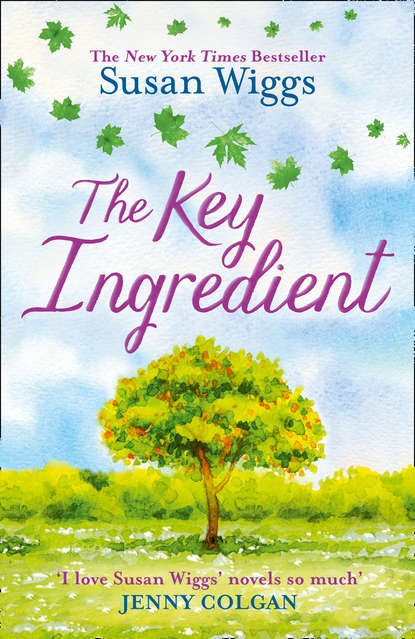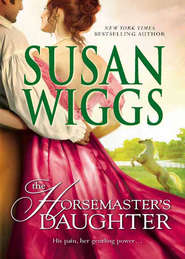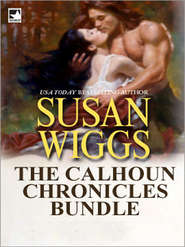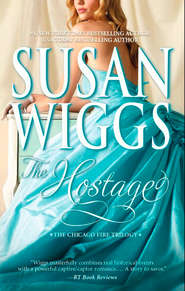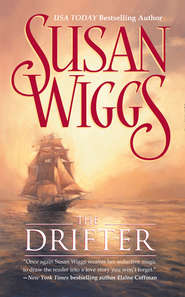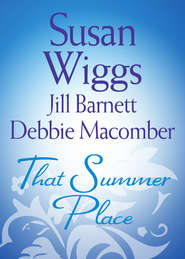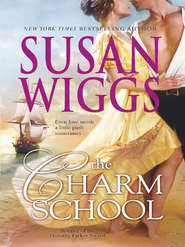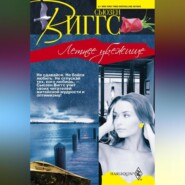По всем вопросам обращайтесь на: info@litportal.ru
(©) 2003-2024.
✖
The Key Ingredient
Автор
Год написания книги
2019
Настройки чтения
Размер шрифта
Высота строк
Поля
The Key Ingredient
Susan Wiggs
From No.1 New York Times best-selling author Susan Wiggs comes a wonderful companion story to her unforgettable novel Family TreeEvery great love story has a beginning. Annie Rush's started at a food cart in a vibrant city park when she came across a charismatic chef serving up gourmet street food. Together Annie and Martin Harlow conceived The Key Ingredient, a cooking show featuring Martin as the star while Annie handles production.As they travel to Annie's Vermont hometown to film their pilot episode, she realizes that she might want to create more than television magic with Martin, but does he feel the same way? When the shoot turns out to be a disaster, Annie can't help but wonder if she is always destined to stay behind the scenes, both at work and in her love life.Just as some recipes come together only at the last minute, Annie hopes that with a bit of good fortune, her life will be transformed into the feast of her dreams.
SUSAN WIGGS
The Key Ingredient
Harper
An imprint of HarperCollinsPublishers Ltd
The News Building
1 London Bridge Street
London SE1 9GF
www.harpercollins.co.uk (http://www.harpercollins.co.uk)
First published in Great Britain by Harper 2016
Copyright © Susan Wiggs 2016
Cover design by Cherie Chapman © HarperCollinsPublishers Ltd 2016Cover images © iStock (house); Shutterstock.com (http://www.Shutterstock.com) (all other images).
Susan Wiggs asserts the moral right to be identified as the author of this work.
A catalogue copy of this book is available from the British Library.
This novel is entirely a work of fiction. The names, characters and incidents portrayed in it are the work of the author’s imagination. Any resemblance to actual persons, living or dead, events or localities is entirely coincidental.
All rights reserved under International and Pan-American Copyright Conventions. By payment of the required fees, you have been granted the non-exclusive, non-transferable right to access and read the text of this e-book on screen. No part of this text may be reproduced, transmitted, down-loaded, decompiled, reverse engineered, or stored in or introduced into any information storage and retrieval system, in any form or by any means, whether electronic or mechanical, now known or hereinafter invented, without the express written permission of HarperCollins.
Ebook Edition © July 2016 ISBN: 9780008205546
Version 2016-06-13
Table of Contents
Cover (#u2cc45996-51f7-561e-891f-b6d650349927)
Title Page (#u060e762d-ec5e-5631-a051-637634ee4412)
Copyright (#ue022f43c-f468-50d6-88fc-bb1e43d22353)
The Key Ingredient (#u8e138865-34c2-5db9-ad3f-8356f8775b55)
Keep Reading... (#litres_trial_promo)
About the Author (#litres_trial_promo)
Also by Susan Wiggs (#litres_trial_promo)
About the Publisher (#litres_trial_promo)
The Key Ingredient (#ud38e4285-fe66-57c1-842f-ca8d2e6cbedc)
Maybe yes, maybe no …
Martin has been flirting with me this whole trip. I pretend to treat it lightly, but come on, Martin Harlow? He’s like a piece of found art, rough around the edges but with a form and function that haunts a girl’s dreams. At the moment, I’m not dreaming, although everyone else in the rental van is. I’m the only one awake besides the driver.
The last leg of the journey is always the hardest. Especially when the journey takes place at the blustery tail end of winter and you’re travelling from the sunny blaze of Los Angeles to the frigid wilds of northern Vermont. After the redeye flight from LA to New York, my production team and I endured a bumpy regional hop to Burlington, followed by a slog in two hired vans to our final destination – Switchback, Vermont.
It’s my hometown, but I haven’t lived here since I graduated high school. What is home? Maybe it’s not a place, but a moment in time. When I was safe. Secure. Cared for. Home. It’s more than a point on a map. It’s a sensation. A feeling of comfort – feet sinking into warm slippers, hands curling around a mug of fragrant coffee, sounds of birdsong, and breezes stirring the leaves in the maple trees. As my mind wraps around the notion of home, everything else falls away. It simply fades like the ambient noise we deal with on set every day when we’re filming a segment for the show.
I grew up knowing that the best maple syrup in the world comes from Vermont. And the best syrup in Vermont comes from Rush Mountain. It’s been my family’s business for generations. And now the production is going to set up, literally, in my own back yard – the family sugar bush on Rush Mountain.
Many times I’ve pictured myself coming back one day in triumph, having chased my dream clear to California and back. I suppose you could say that’s what I’m doing now, because I’m about to begin filming the pilot episode of a TV series I created.
When we pitched the show to the network, I was asked how I came up with the name, The Key Ingredient. The truth is, I had the name long before I had the show. It comes from the wisest woman I’ve ever known – Anastasia Carnaby Rush, my grandmother. Gran used to say each recipe has a key ingredient – one element that defines it, without which the dish simply wouldn’t be the same, like the vinegar in a red velvet cake, the threads of saffron in paella, or the four pods of star anise she used to tuck into the pasta sauce as it simmered on the back burner.
What she really meant had nothing to do with a recipe you make in the kitchen. I’ve always regretted that I didn’t figure that out sooner.
I wish Gran were still around for my homecoming, even though it’s for work and the budget only allows us seventy-two hours for filming. She would have been so happy for me.
When I was growing up, Gran and I watched hours and hours of PBS cooking shows together. This was in the 1990s, before the food channels that are so ubiquitous these days exploded onto the scene. The older shows were pretty basic – a well-equipped kitchen, an island counter, a chopping board, and four burners. Yet even the most pared-down, simple production inspired us if the chef had a great personality. We loved it when the host would talk of his travels and share the stories behind the food, all the while demonstrating kitchen techniques we could learn from. I learned to fold, cream, julienne and sauté by watching Martin Yan, Chef Tell and Molto Mario, while Gran wrote down the recipes so we could recreate them at home.
Even back then, it wasn’t just the cooking techniques that drew me in. I was fascinated by the whole idea of a kitchen rigged with cameras so a talented chef or home cook could share their art. I dreamed of being in the spotlight myself, showing the world how to make egg pasta or maple-glazed carrots or rosemary lemonade. Our family photo albums are stuffed with snapshots of me giving pretend demos to a rapt audience of dolls, dogs or grandparents. While other kids were building with Lego, I was practicing my knife skills.
At the age of nine I got a digital video camcorder for Christmas. When I learned what that big, cumbersome camera could do, it was as if I’d seen the face of God. Not only could I dream up my own shows and episodes, I could film them and play them back.
Gran was a really good sport about it all. She let me set the camera on its tripod and play unfortunate selections of background music while I interviewed her.
‘I was never homesick,’ she said, talking to me – not the camera. ‘This place has always felt more like home to me than the big city. You see, I believe some people are born in the place they belong. Others have to go looking for it. That was me: I went looking, and I found this place. It’s my heart’s home, and I thank God every day that I’m able to spend my life here.’
She talked of her life in Boston and how, as a young woman, she worked in a restaurant called Durgin-Park. It was a place that had been in existence for three hundred years. The tourists would come for baked beans and to be sassed by the waitresses. It was there, during the lunch rush, that she met a handsome Vermonter who had come down one summer weekend to see the sights of Boston. She proudly told everyone that, yes, she sassed him. At Durgin-Park it was expected.
Less than a year later she bade her family farewell and boarded a train up to Vermont, which in those days was as distant and untamed as the Wild West, to hear her tell it.
With the red camera light running and me directing things with zero expertise but an excess of enthusiasm, she created many of the family favourites. Somewhere in my digital archives there’s footage of her making ice cream pie, scalloped potatoes, squash roasted with maple butter and salt, potato and ricotta gnocchi, salads bright with tomatoes just harvested in her legendary summer garden, home-made jam from the berries we picked, crisp pickles preserved without one single drop of vinegar.
If you ever watch a cooking show, pay close attention to the chef’s hands. The very best chefs on the air handle food with grace and confidence – and with love. Even in the grainy old digital files of my grandmother, back when my camera skills were rudimentary at best, you can still see this trait. She is absolutely sure of herself in the kitchen – and driven by a mission to care for people by feeding them. When preparing a meal, a good chef knows instinctively that love is the key ingredient, no matter what else you add to the dish. In fact, that’s how I came up with the name for the show I produce – The Key Ingredient.
As a student in film school, the last thing I expected was to be the creative force behind a hit cooking show.
Confession: my real dream was to be the creative force in front of the camera, too. That’s not how events unfolded, but I can’t complain. I did the next best thing. I discovered the talented, charismatic, totally hot chef who was chosen to host the show – Martin Harlow.
He was a food cart chef in Washington Square Park, just barely scraping by but attracting an avid following of foodies who appreciated his culinary skills and groupies who admired his matinée-idol looks. I was a film student at NYU’s Tisch School, trying to recover from a shattered heart after walking away from the best man I’d ever known.
Susan Wiggs
From No.1 New York Times best-selling author Susan Wiggs comes a wonderful companion story to her unforgettable novel Family TreeEvery great love story has a beginning. Annie Rush's started at a food cart in a vibrant city park when she came across a charismatic chef serving up gourmet street food. Together Annie and Martin Harlow conceived The Key Ingredient, a cooking show featuring Martin as the star while Annie handles production.As they travel to Annie's Vermont hometown to film their pilot episode, she realizes that she might want to create more than television magic with Martin, but does he feel the same way? When the shoot turns out to be a disaster, Annie can't help but wonder if she is always destined to stay behind the scenes, both at work and in her love life.Just as some recipes come together only at the last minute, Annie hopes that with a bit of good fortune, her life will be transformed into the feast of her dreams.
SUSAN WIGGS
The Key Ingredient
Harper
An imprint of HarperCollinsPublishers Ltd
The News Building
1 London Bridge Street
London SE1 9GF
www.harpercollins.co.uk (http://www.harpercollins.co.uk)
First published in Great Britain by Harper 2016
Copyright © Susan Wiggs 2016
Cover design by Cherie Chapman © HarperCollinsPublishers Ltd 2016Cover images © iStock (house); Shutterstock.com (http://www.Shutterstock.com) (all other images).
Susan Wiggs asserts the moral right to be identified as the author of this work.
A catalogue copy of this book is available from the British Library.
This novel is entirely a work of fiction. The names, characters and incidents portrayed in it are the work of the author’s imagination. Any resemblance to actual persons, living or dead, events or localities is entirely coincidental.
All rights reserved under International and Pan-American Copyright Conventions. By payment of the required fees, you have been granted the non-exclusive, non-transferable right to access and read the text of this e-book on screen. No part of this text may be reproduced, transmitted, down-loaded, decompiled, reverse engineered, or stored in or introduced into any information storage and retrieval system, in any form or by any means, whether electronic or mechanical, now known or hereinafter invented, without the express written permission of HarperCollins.
Ebook Edition © July 2016 ISBN: 9780008205546
Version 2016-06-13
Table of Contents
Cover (#u2cc45996-51f7-561e-891f-b6d650349927)
Title Page (#u060e762d-ec5e-5631-a051-637634ee4412)
Copyright (#ue022f43c-f468-50d6-88fc-bb1e43d22353)
The Key Ingredient (#u8e138865-34c2-5db9-ad3f-8356f8775b55)
Keep Reading... (#litres_trial_promo)
About the Author (#litres_trial_promo)
Also by Susan Wiggs (#litres_trial_promo)
About the Publisher (#litres_trial_promo)
The Key Ingredient (#ud38e4285-fe66-57c1-842f-ca8d2e6cbedc)
Maybe yes, maybe no …
Martin has been flirting with me this whole trip. I pretend to treat it lightly, but come on, Martin Harlow? He’s like a piece of found art, rough around the edges but with a form and function that haunts a girl’s dreams. At the moment, I’m not dreaming, although everyone else in the rental van is. I’m the only one awake besides the driver.
The last leg of the journey is always the hardest. Especially when the journey takes place at the blustery tail end of winter and you’re travelling from the sunny blaze of Los Angeles to the frigid wilds of northern Vermont. After the redeye flight from LA to New York, my production team and I endured a bumpy regional hop to Burlington, followed by a slog in two hired vans to our final destination – Switchback, Vermont.
It’s my hometown, but I haven’t lived here since I graduated high school. What is home? Maybe it’s not a place, but a moment in time. When I was safe. Secure. Cared for. Home. It’s more than a point on a map. It’s a sensation. A feeling of comfort – feet sinking into warm slippers, hands curling around a mug of fragrant coffee, sounds of birdsong, and breezes stirring the leaves in the maple trees. As my mind wraps around the notion of home, everything else falls away. It simply fades like the ambient noise we deal with on set every day when we’re filming a segment for the show.
I grew up knowing that the best maple syrup in the world comes from Vermont. And the best syrup in Vermont comes from Rush Mountain. It’s been my family’s business for generations. And now the production is going to set up, literally, in my own back yard – the family sugar bush on Rush Mountain.
Many times I’ve pictured myself coming back one day in triumph, having chased my dream clear to California and back. I suppose you could say that’s what I’m doing now, because I’m about to begin filming the pilot episode of a TV series I created.
When we pitched the show to the network, I was asked how I came up with the name, The Key Ingredient. The truth is, I had the name long before I had the show. It comes from the wisest woman I’ve ever known – Anastasia Carnaby Rush, my grandmother. Gran used to say each recipe has a key ingredient – one element that defines it, without which the dish simply wouldn’t be the same, like the vinegar in a red velvet cake, the threads of saffron in paella, or the four pods of star anise she used to tuck into the pasta sauce as it simmered on the back burner.
What she really meant had nothing to do with a recipe you make in the kitchen. I’ve always regretted that I didn’t figure that out sooner.
I wish Gran were still around for my homecoming, even though it’s for work and the budget only allows us seventy-two hours for filming. She would have been so happy for me.
When I was growing up, Gran and I watched hours and hours of PBS cooking shows together. This was in the 1990s, before the food channels that are so ubiquitous these days exploded onto the scene. The older shows were pretty basic – a well-equipped kitchen, an island counter, a chopping board, and four burners. Yet even the most pared-down, simple production inspired us if the chef had a great personality. We loved it when the host would talk of his travels and share the stories behind the food, all the while demonstrating kitchen techniques we could learn from. I learned to fold, cream, julienne and sauté by watching Martin Yan, Chef Tell and Molto Mario, while Gran wrote down the recipes so we could recreate them at home.
Even back then, it wasn’t just the cooking techniques that drew me in. I was fascinated by the whole idea of a kitchen rigged with cameras so a talented chef or home cook could share their art. I dreamed of being in the spotlight myself, showing the world how to make egg pasta or maple-glazed carrots or rosemary lemonade. Our family photo albums are stuffed with snapshots of me giving pretend demos to a rapt audience of dolls, dogs or grandparents. While other kids were building with Lego, I was practicing my knife skills.
At the age of nine I got a digital video camcorder for Christmas. When I learned what that big, cumbersome camera could do, it was as if I’d seen the face of God. Not only could I dream up my own shows and episodes, I could film them and play them back.
Gran was a really good sport about it all. She let me set the camera on its tripod and play unfortunate selections of background music while I interviewed her.
‘I was never homesick,’ she said, talking to me – not the camera. ‘This place has always felt more like home to me than the big city. You see, I believe some people are born in the place they belong. Others have to go looking for it. That was me: I went looking, and I found this place. It’s my heart’s home, and I thank God every day that I’m able to spend my life here.’
She talked of her life in Boston and how, as a young woman, she worked in a restaurant called Durgin-Park. It was a place that had been in existence for three hundred years. The tourists would come for baked beans and to be sassed by the waitresses. It was there, during the lunch rush, that she met a handsome Vermonter who had come down one summer weekend to see the sights of Boston. She proudly told everyone that, yes, she sassed him. At Durgin-Park it was expected.
Less than a year later she bade her family farewell and boarded a train up to Vermont, which in those days was as distant and untamed as the Wild West, to hear her tell it.
With the red camera light running and me directing things with zero expertise but an excess of enthusiasm, she created many of the family favourites. Somewhere in my digital archives there’s footage of her making ice cream pie, scalloped potatoes, squash roasted with maple butter and salt, potato and ricotta gnocchi, salads bright with tomatoes just harvested in her legendary summer garden, home-made jam from the berries we picked, crisp pickles preserved without one single drop of vinegar.
If you ever watch a cooking show, pay close attention to the chef’s hands. The very best chefs on the air handle food with grace and confidence – and with love. Even in the grainy old digital files of my grandmother, back when my camera skills were rudimentary at best, you can still see this trait. She is absolutely sure of herself in the kitchen – and driven by a mission to care for people by feeding them. When preparing a meal, a good chef knows instinctively that love is the key ingredient, no matter what else you add to the dish. In fact, that’s how I came up with the name for the show I produce – The Key Ingredient.
As a student in film school, the last thing I expected was to be the creative force behind a hit cooking show.
Confession: my real dream was to be the creative force in front of the camera, too. That’s not how events unfolded, but I can’t complain. I did the next best thing. I discovered the talented, charismatic, totally hot chef who was chosen to host the show – Martin Harlow.
He was a food cart chef in Washington Square Park, just barely scraping by but attracting an avid following of foodies who appreciated his culinary skills and groupies who admired his matinée-idol looks. I was a film student at NYU’s Tisch School, trying to recover from a shattered heart after walking away from the best man I’d ever known.





